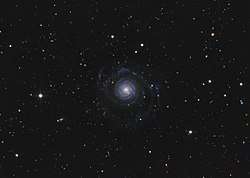NGC 3642
NGC 3642 is a spiral galaxy in constellation Ursa Major. The galaxy has a low-ionization nuclear emission-line region. It is located at a distance of circa 30 million light years from Earth, which, given its apparent dimensions, means that NGC 3642 is about 50,000 light years across. The galaxy is characterised by an outer pseudoring, which was probably formed after the accretion of gas rich dwarf galaxy.[2]
| NGC 3642 | |
|---|---|
 NGC 3642 as taken by Mount Lemmon SkyCenter | |
| Observation data (J2000 epoch) | |
| Constellation | Ursa Major |
| Right ascension | 11h 22m 17.9s[1] |
| Declination | 59° 04′ 28″[1] |
| Redshift | 1571 ± 3 km/s[1] |
| Distance | 27 ± 35 Mly (8.4 ± 10.7 Mpc)[1] |
| Apparent magnitude (V) | 10.8 |
| Characteristics | |
| Type | SA(r)bc[1] |
| Apparent size (V) | 1′.8 × 1′.5[1] |
| Other designations | |
| UGC 6385, MCG +10-16-128, PGC 34889[1] | |
Structure
NGC 3642 is a spiral galaxy without bar.[2] In the nucleus there is a supermassive black hole with estimated mass 26-31 millions M⊙, based on the intrinsic velocity dispersion as measured by the Hubble Space Telescope,[3] or 15 millions M⊙, based on the bulge luminosities in near-infrared Ks-band.[4]
Around the nucleus, a one-armed spiral forms a ring, and it is possible that it leads material towards the nucleus. The nucleus surrounded by an inner flocculent spiral. The outer part of the spiral forms a pseudoring that extents for about half a circle. The outer part of the spiral is warped, while its main part features an ordinary differentially rotating disk. The HI gas is also warped and extents more in the western side.[2]
Nearby galaxies
The galaxy belongs in NGC 3642 group[5] (also known as NGC 3610 group), a galaxy group that also includes NGC 3610, NGC 3619, NGC 3669, NGC 3674 and NGC 3683. Other nearby galaxies include NGC 3440, NGC 3445, NGC 3458, NGC 3543 and NGC 3613.[6]
References
- "NASA/IPAC Extragalactic Database". Results for NGC 3642. Retrieved 2016-01-18.
- Verdes–Montenegro, L.; Bosma, A.; Athanassoula, E. (1 July 2002). "Star formation in the warped outer pseudoring of the spiral galaxy NGC 3642". Astronomy & Astrophysics. 389 (3): 825–835. arXiv:astro-ph/0205088. Bibcode:2002A&A...389..825V. doi:10.1051/0004-6361:20020680. Retrieved 17 July 2017.
- Beifiori, A.; Sarzi, M.; Corsini, E. M.; Bontà, E. Dalla; Pizzella, A.; Coccato, L.; Bertola, F. (10 February 2009). "Upper Limits on the Masses of 105 Supermassive Black Holes from Hubble Space Telescope/Space Telescope Imaging Spectrograph Archival Data". The Astrophysical Journal. 692 (1): 856–868. arXiv:0809.5103. Bibcode:2009ApJ...692..856B. doi:10.1088/0004-637X/692/1/856.
- Dong, X. Y.; De Robertis, M. M. (March 2006). "Low-Luminosity Active Galaxies and Their Central Black Holes". The Astronomical Journal. 131 (3): 1236–1252. arXiv:astro-ph/0510694. Bibcode:2006AJ....131.1236D. doi:10.1086/499334.
- Warren H. Finlay (2014). Concise Catalog of Deep-Sky Objects: Astrophysical Information for 550 Galaxies, Clusters and Nebulae The Patrick Moore Practical Astronomy Series. Springer. p. 258. ISBN 9783319031705.
- Makarov, Dmitry; Karachentsev, Igor (21 April 2011). "Galaxy groups and clouds in the local (z∼ 0.01) Universe". Monthly Notices of the Royal Astronomical Society. 412 (4): 2498–2520. arXiv:1011.6277. Bibcode:2011MNRAS.412.2498M. doi:10.1111/j.1365-2966.2010.18071.x.
External links
| Wikimedia Commons has media related to NGC 3642. |
- NGC 3642 on WikiSky: DSS2, SDSS, GALEX, IRAS, Hydrogen α, X-Ray, Astrophoto, Sky Map, Articles and images